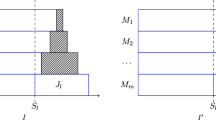Abstract
Our main result improves the known processor bound by a factor ofn 4 (maintaining the expected parallel running time,O(log3 n)) for the following important problem:find a perfect matching in a general or in a bipartite graph with n vertices. A solution to that problem is used in parallel algorithms for several combinatorial problems, in particular for the problems of finding i) a (perfect) matching of maximum weight, ii) a maximum cardinality matching, iii) a matching of maximum vertex weight, iv) a maximums-t flow in a digraph with unit edge capacities. Consequently the known algorithms for those problems are substantially improved.
Similar content being viewed by others

References
S. Berkowitz, On Computing the Determinant in Small Parallel Time Using a Small Number of Processors,Information Processing Letters.18 (1984), 147–150.
A. Borodin, S. Cook andN. Pippenger, Parallel Computation for Well-Endowed Rings and and Space-Bounded Probabilistic Machines,Inform, and Control,58 (1983), 113–136.
A. Borodin, J. von zur Gathen andJ. Hopcroft, Fast Parallel Matrix and GCD Computations,Inform. and Control,53 (1982), 241–256.
A.Broder,private communication, 1985.
D.Coppersmith and S.Winograd, Matrix Multiplication via Arithmetic Progressions,Proc. 19th Ann. ACM Symp. on Theory of Computing, 1987, 1–6.
H.Gabow,private communication, 1985.
R. M.Karp, E.Uffal and A.Wigderson, Constructing a Perfect Matching Is in Random NC,Proc. 17-th Ann. ACM Symp. on Theory of Computing, (1985), 22–32.
M. Marcus andH. Minc,A Survey of Matrix Theory and Matrix Inequalities, Allyn and Bacon, Boston, 1964.
K. Mulmuley, U. Vazirani andV. Vazirani, Matching Is As Easy As Matrix Inversion,Combinatorica,7 (1987), 105–114.
V. Pan, Fast and Efficient Parallel Algorithms for Exact Inversion of Integer Matrices,Proc. Fifth Conf. on Software Technology and Theoretical Computer Science, Computer Science,206 (1985), 504–521; Complexity of Parallel Matrix Computations,Theoretical Computer Science,54 (1987) (to appear).
F. P. Preparata andD. V. Sarwate, An Improved Parallel Processor Bound in Fast Matrix Inversion,Inform. Proc. Letters,7 (1978), 148–149.
M. O.Rabin and V.Vazirani, Maximum Matchings in Graphs through RandomizationTech. Report TR-I5-84, Center for Research in Computer Technology, Aiken Computation Laboratory, Harvard University, 1984.
J. E. Savage,The Complexity of Computing, John Wiley and Sons, N.Y., 1976.
J. T. Schwartz, Fast Probabilistic Algorithms for Verification of Polynomial Identities,J. of ACM,27 (1980), 701–717.
D. Y. Y.Yun, Algebraic Algorithms Usingp-adic Constructions,Proc. 1976 ACM Symp, Symbolic and Algebraic Computation, (1976), 248–259.
Author information
Authors and Affiliations
Additional information
Partially supported by NSF Grants MCS 8303139 and DCR 8511713.
Supporeted by NSF Grants MCS 8203232 and DCR 8507573.
Rights and permissions
About this article
Cite this article
Galil, Z., Pan, V. Improved processor bounds for combinatorial problems in RNC. Combinatorica 8, 189–200 (1988). https://doi.org/10.1007/BF02122800
Received:
Revised:
Issue Date:
DOI: https://doi.org/10.1007/BF02122800



